Pioneer S-21W User Manual [ru]

S-21W
S-11
Powered Subwoofer
Enceinte Active d’Extrêmes Graves Aktiver Subwoofer
Subwoofer Attiv
Subwoofer Met Spanningscircuit
Altavoces De Graves Secundarios Energizados
Активньιй Сабвуфер
Speaker System / Enceintes acoustiques / Lautsprechersystem /
Sistema di diffusori / Luidsprekersysteem / Sistema de altavoces /
Aкустическая система / ġ/
Discover the benefits of registering your product online at http://www.pioneer.co.uk (or http://www.pioneer.eu). Découvrez les nombreux avantages offerts en enregistrant votre produit en ligne maintenant sur http://www.pioneer.fr
(ou http://www.pioneer.eu).
Bitte nutzen Sie die Möglichkeit zur Registrierung Ihres Produktes unter http://www.pioneer.de (oder http://www.pioneer.eu)
Registra il tuo prodotto su http://www.pioneer.it (o http://www.pioneer.eu) e scopri subito quali vantaggi puoi ottenere! Ontdek nu de voordelen van online registratie! Registreer uw Pioneer product via
http://www.pioneer.nl - http://www.pioneer.be (of http://www.pioneer.eu)
Registre su producto en http://www.pioneer.es (o en http://www.pioneer.eu) Descubra los beneficios de registrarse
on-line:
Зарегистрируйте Baшe изделие на http://www.pioneer-rus.ru (или http://www.pioneer.eu).
Oзнакомьтесь с преимуществами регистрации в Интернет
http://pioneer.jp/support/
Register Your Product on: |
Enregistrez votre produit sur : |
http://www.pioneerelectronics.com (US) |
http://www.pioneerelectronics.com (États-unis) |
http://www.pioneerelectronics.ca (Canada) |
http://www.pioneerelectronics.ca (Canada) |
Operating Instructions / Mode d’emploi / Bedienungsanleitung / Istruzioni per l’uso / Handleiding / |
|
Manual de instrucciones / Инструкции по зксплуатации / |
/ |
BZ02
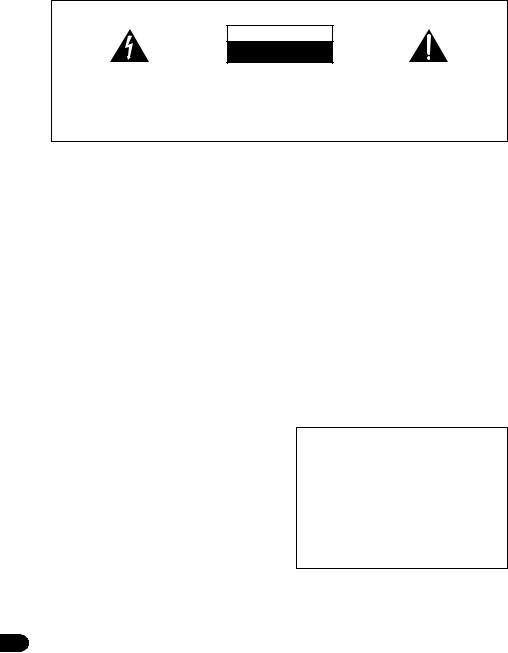
Thank you for buying this PIONEER product. Please read through these operating instructions so you will know how to operate your model properly. After you have finished reading the instructions, put them away in a safe place for future reference.
These operating instructions have has been written for joint use with the S-21W and S-11 models. Please consult those portions of the manual indicated for your model.
IMPORTANT
CAUTION
RISK OF ELECTRIC SHOCK
DO NOT OPEN
The lightning flash with arrowhead symbol, within an equilateral triangle, is intended to alert the user to the presence of uninsulated “dangerous voltage” within the product’s enclosure that may be of sufficient magnitude to constitute a risk of electric shock to persons.
CAUTION:
TO PREVENT THE RISK OF ELECTRIC SHOCK, DO NOT REMOVE COVER (OR BACK). NO USER-SERVICEABLE PARTS INSIDE. REFER SERVICING TO QUALIFIED SERVICE PERSONNEL.
The exclamation point within an equilateral triangle is intended to alert the user to the presence of important operating and maintenance (servicing) instructions in the literature accompanying the appliance.
D3-4-2-1-1_A1_En
WARNING
This equipment is not waterproof. To prevent a fire or shock hazard, do not place any container filled with liquid near this equipment (such as a vase or flower pot) or expose it to dripping, splashing, rain or moisture.
D3-4-2-1-3_A1_En
WARNING
Before plugging in for the first time, read the following section carefully.
The voltage of the available power supply differs according to country or region. Be sure that the power supply voltage of the area where this unit will be used meets the required voltage (e.g., 230 V or 120 V) written on the rear panel.
D3-4-2-1-4*_A1_En
WARNING
To prevent a fire hazard, do not place any naked flame sources (such as a lighted candle) on the equipment.
D3-4-2-1-7a_A1_En
VENTILATION CAUTION
When installing the subwoofer, make sure to leave space around the unit for ventilation to improve heat radiation (at least 10 cm at top, 10 cm at rear, and 10 cm at each side).
WARNING
Slots and openings in the cabinet are provided for ventilation to ensure reliable operation of the product, and to protect it from overheating. To prevent fire hazard, the openings should never be blocked or covered with items (such as newspapers, table-cloths, curtains) or by operating the equipment on thick carpet or a bed.
D3-4-2-1-7b*_A1_En
Operating Environment
Operating environment temperature and humidity:
+5 °C to +35 °C (+41 °F to +95 °F); less than 85 %RH (cooling vents not blocked) Do not install this unit in a poorly ventilated area, or in locations exposed to high humidity or direct sunlight (or strong artificial light)
D3-4-2-1-7c*_A1_En
If the AC plug of this unit does not match the AC outlet you want to use, the plug must be removed and appropriate one fitted. Replacement and mounting of an AC plug on the power supply cord of this unit should be performed only by qualified service personnel. If connected to an AC outlet, the cut-off plug can cause severe electrical shock. Make sure it is properly disposed of after removal.
The equipment should be disconnected by removing the mains plug from the wall socket when left unused for a long period of time (for example, when on vacation).
D3-4-2-2-1a_A1_En
2
En
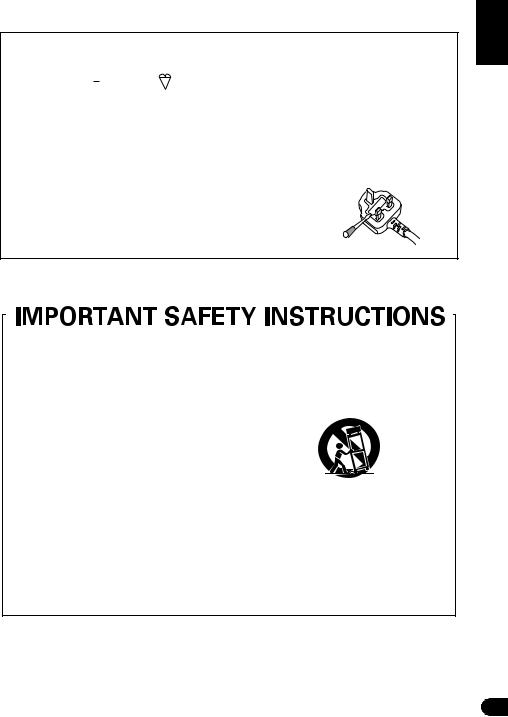
For U.K. model and Singapore model only
Replacement and mounting of an AC plug on the power supply cord of this unit should be performed only by qualified service personnel.
IMPORTANT: THE MOULDED PLUG
This appliance is supplied with a moulded three pin mains plug for your safety and convenience. A 5 amp fuse is fitted in this plug.
Should the fuse need to be replaced, please ensure that the replacement fuse has a rating of 5 amps and that it is approved by ASTA or BSI to BS1362.
Check for the ASTA mark  or the BSI mark
or the BSI mark  on the body of the fuse.
on the body of the fuse.
If the plug contains a removable fuse cover, you must ensure that it is refitted when the fuse is replaced. If you lose the fuse cover the plug must not be used until a replacement cover is obtained. A replacement fuse cover can be obtained from your local dealer.
If the fitted moulded plug is unsuitable for your socket outlet, then the fuse shall be removed and the plug cut off and disposed of safely. There is a danger of severe electrical shock if the cut off plug is inserted into any 13 amp socket.
If a new plug is to be fitted, please observe the wiring code as shown below. If in any doubt, please consult a qualified electrician.
IMPORTANT: The wires in this mains lead are coloured in accordance with the following code: Blue : Neutral Brown : Live
As the colours of the wires in the mains lead of this appliance may not correspond with the coloured markings identifying the terminals in your plug, proceed as follows; 
The wire which is coloured BLUE must be connected to the terminal which is marked with the letter N or coloured BLACK. The wire which is coloured BROWN must be connected to the terminal which is marked with the
letter L or coloured RED.
How to replace the fuse: Open the fuse compartment with a screwdriver and replace the fuse.
D3-4-2-1-2-2*_A2_En
1)Read these instructions.
2)Keep these instructions.
3)Heed all warnings.
4)Follow all instructions.
5)Do not use this apparatus near water.
6)Clean only with dry cloth.
7)Do not block any ventilation openings. Install in accordance with the manufacturer’s instructions.
8)Do not install near any heat sources such as radiators, heat registers, stoves, or other apparatus (including amplifiers) that produce heat.
9)Do not defeat the safety purpose of the polarized or grounding-type plug. A polarized plug has two blades with one wider than the other. A grounding type plug has two blades and a third grounding prong. The wide blade or the third prong are provided for your safety. If the provided plug does not fit into your outlet, consult an electrician for replacement of the obsolete outlet.
10)Protect the power cord from being walked on or pinched particularly at plugs, convenience receptacles, and the point where they exit from the apparatus.
.
11)Only use attachments/accessories specified by the manufacturer.
12)Use only with the cart, stand, tripod, bracket, or table specified by the manufacturer, or sold with the apparatus. When a cart is used, use caution when moving the cart/apparatus combination to avoid injury from tip-over.
13)Unplug this apparatus during lightning storms or when unused for long periods of time.
14)Refer all servicing to qualified service personnel. Servicing is required when the apparatus has been damaged in any way, such as power-supply cord or plug is damaged, liquid has been spilled or objects have fallen into the apparatus, the apparatus has been exposed to rain or moisture, does not operate normally, or has been dropped.
D3-7-13-69_En
Pyccкий Español Nederlands Italiano Deutsch Français English
3
En

CAUTION
The POWER switch on this unit will not completely shut off all power from the AC outlet. Since the power cord serves as the main disconnect device for the unit, you will need to unplug it from the AC outlet to shut down all power. Therefore, make sure the unit has been installed so that the power cord can be easily unplugged from the AC outlet in case of an accident. To avoid fire hazard, the power cord should also be unplugged from the AC outlet when left unused for a long period of time (for example, when on vacation).
D3-4-2-2-2a*_A1_En
Information to User
Alterations or modifications carried out without appropriate authorization may invalidate the user’s right to operate the equipment.
D8-10-2_A1_En
This Class B digital apparatus complies with Canadian ICES-003.
D8-10-1-3_A1_En
POWER-CORD CAUTION
Handle the power cord by the plug. Do not pull out the plug by tugging the cord and never touch the power cord when your hands are wet as this could cause a short circuit or electric shock.
WARNING:
Do not climb or sit on this unit. Be especially careful when children are around. The unit may be damaged, or may fall over causing injury.
NOTE:
This equipment has been tested and found to comply with the limits for a Class B digital device, pursuant to Part 15 of the FCC Rules. These limits are designed to provide reasonable protection against harmful interference in a residential installation. This equipment generates, uses, and can radiate radio frequency energy and, if not installed and used in accordance with the instructions, may cause harmful interference to radio communications. However, there is no guarantee that interference will not occur in a particular installation. If this equipment does cause harmful interference to radio or television reception, which can be determined by turning the equipment off and on, the user is encouraged to try to correct the interference by one or more of the following measures:
—Reorient or relocate the receiving antenna.
—Increase the separation between the equipment and receiver.
—Connect the equipment into an outlet on a circuit different from that to which the receiver is connected.
—Consult the dealer or an experienced radio/TV technician for help.
D8-10-1-2_A1_En
For Europe model only
If you want to dispose this product, do not mix it with general household waste. There is a separate collection system for used electronic products in accordance with legislation that requires proper treatment, recovery and recycling.
Private households in the member states of the EU, in Switzerland and Norway may return their used electronic products free of charge to designated collection facilities or to a retailer (if you purchase a similar new one).
For countries not mentioned above, please contact your local authorities for the correct method of disposal.
By doing so you will ensure that your disposed product undergoes the necessary treatment, recovery and recycling and thus prevent potential negative effects on the environment and human health.
K058b_A1_En
4
En
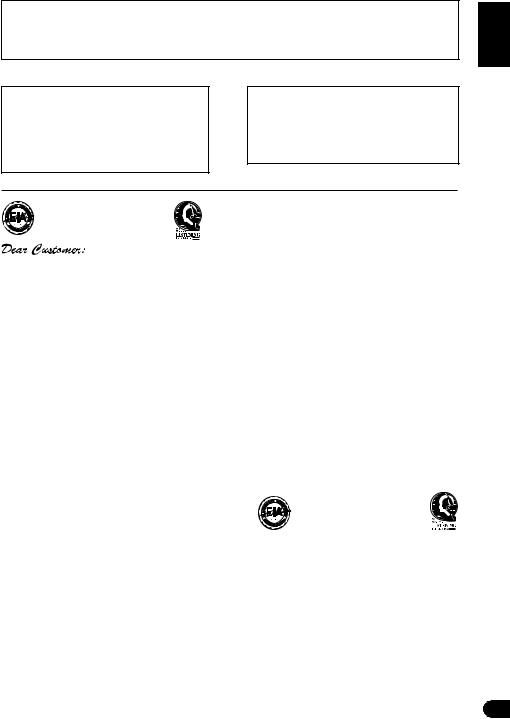
IMPORTANT NOTICE
THE MODEL NUMBER AND SERIAL NUMBER OF THIS EQUIPMENT ARE ON THE REAR.
RECORD THESE NUMBERS ON YOUR ENCLOSED WARRANTY CARD AND KEEP IN A SAFE PLACE FOR FUTURE REFERENCE.
D36-AP9-1_A1_En
For U.S. model only
WARNING: Handling the cord on this product or cords associated with accessories sold with the product may expose you to chemicals listed on proposition 65 known to the State of California and other governmental entities to cause cancer and birth defect or other reproductive harm.
Wash hands after handling.
D36-P5_B1_En
This product is for general household purposes. Any failure due to use for other than household purposes (such as long-term use for business purposes in a restaurant or use in a car or ship) and which requires repair will be charged for even during the warranty period.
K041_A1_En
Selecting fine audio equipment such as the unit you’ve just purchased is only the start of your musical enjoyment. Now it’s time to consider how you can maximize the fun and excitement your equipment offers. This manufacturer and the Electronic Industries Association’s Consumer Electronics Group want you to get the most out of your equipment by playing it at a safe level. One that lets the sound come through loud and clear without annoying blaring or distortion-and, most importantly, without affecting your sensitive hearing.
Sound can be deceiving. Over time your hearing “comfort level” adapts to higher volumes of sound. So what sounds “normal” can actually be loud and harmful to your hearing. Guard against this by setting your equipment at a safe level BEFORE your hearing adapts.
To establish a safe level:
•Start your volume control at a low setting.
•Slowly increase the sound until you can hear it comfortably and clearly, and without distortion.
Once you have established a comfortable sound level:
• Set the dial and leave it there.
Taking a minute to do this now will help to prevent hearing damage or loss in the future. After all, we want you listening for a lifetime.
We Want You Listening For A Lifetime
Used wisely, your new sound equipment will provide a lifetime of fun and enjoyment. Since hearing damage from loud noise is often undetectable until it is too late, this manufacturer and the Electronic Industries Association’s Consumer Electronics Group recommend you avoid prolonged exposure to excessive noise. This list of sound levels is included for your protection.
Decibel
Level Example
30 Quiet library, soft whispers
40 Living room, refrigerator, bedroom away from traffic 50 Light traffic, normal conversation, quiet office 60 Air conditioner at 20 feet, sewing machine 70 Vacuum cleaner, hair dryer, noisy restaurant
80Average city traffic, garbage disposals, alarm clock at two feet.
THE FOLLOWING NOISES CAN BE DANGEROUS UNDER CONSTANT EXPOSURE
90 Subway, motorcycle, truck traffic, lawn mower 100 Garbage truck, chain saw, pneumatic drill 120 Rock band concert in front of speakers, thunderclap
140 Gunshot blast, jet plane
180 Rocket launching pad
Information courtesy of the Deafness Research Foundation.
S001_A1_En
Pyccкий Español Nederlands Italiano Deutsch Français English
5
En
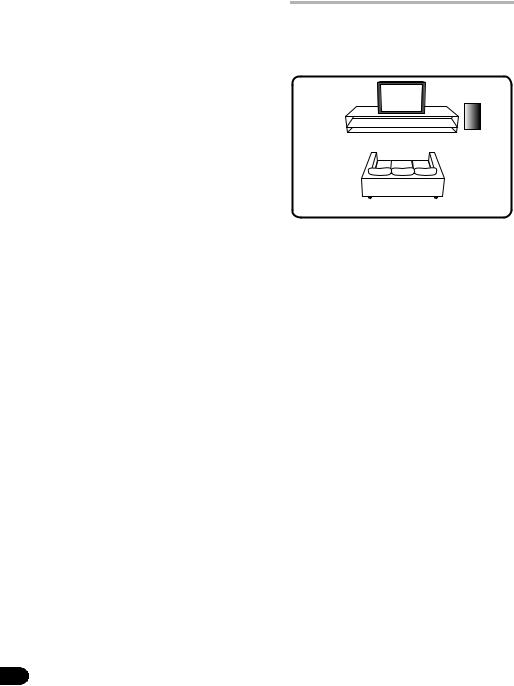
Contents |
Installation |
Features ............................................... |
6 |
Accessory Items .................................. |
6 |
Installation .......................................... |
6 |
Connections and Use (S-21W) ............ |
8 |
Connections and Use (S-11).............. |
10 |
Specifications.................................... |
12 |
Troubleshooting ............................... |
13 |
Features
S-21W
•High Power 160 W (Peak)
•Compact Design and Deep Bass Sound
•Phase Control Technology
S-11
•150 W Power Handling
•Round shape enclosure
•Phase Control Technology
Accessory Items
S-21W
•RCA plug cord (3 m) x 1
•Power cord
S-11
•Speaker cords (4 m) x 3
•Speaker cords (10 m) x 2
•Non-Skid Pads x 20
•Brackets for wall mounting x 4
•Screw (M5) x 4
Applies to both S-21W and S-11
•Warranty card
•Operating instructions (this document)
6
Speaker installation
• As shown in the accompanying illustration, when surround speakers are installed to the rear of the listening position, you can enjoy genuine 5.1 channel surround sound.
1 3
2 4
6 |
7 |
5
1Front left speaker
2Center speaker
3Front right speaker
4Subwoofer
5Listening position
6Surround left speaker
7Surround right speaker
•The subwoofer and surround speakers in this system cannot be used nearby a CRTbased TV or color monitor. When using this kind of CRT-based TV or color monitor, install the speakers away from the display device. Any other device liable to be influenced by magnetism (floppy disk drive, cassette tape recorder, video tape player, etc.) should also be kept at a distance from the subwoofer and surround speakers.
Subwoofer (S-21W)
•When moving the subwoofer, avoid touching the bottom surface, since the speaker unit is located there.
•Orient the subwoofer’s front face pointing toward the listening position.
•The subwoofer plays back the bass in monaural, making use of the fact that the human ear is not very sensitive to the direction of low-pitched sound. Because of this, the subwoofer can be installed almost anywhere. If it is installed too far away, however, the sound from the other speakers may become unnatural.
The degree of bass effect can be adjusted by moving the unit farther from or closer to the wall.
En
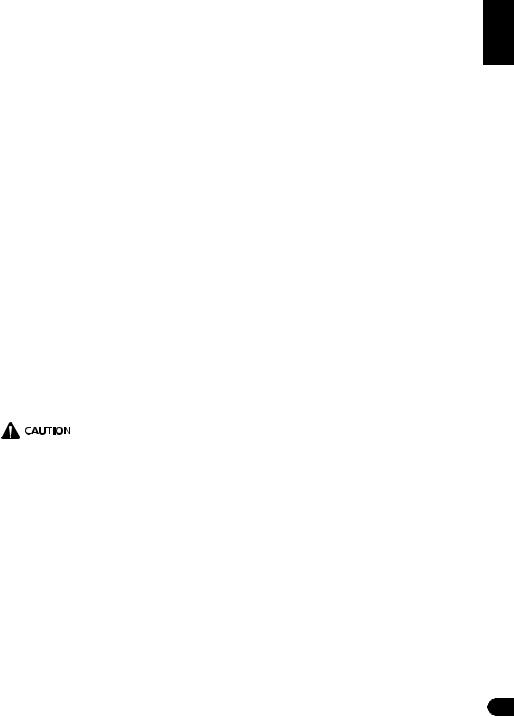
Satellite speakers (S-11)
•Labels located on the rear of each speaker indicate whether they are designed for front or surround use.
•Speakers installed to the right and left should be separated by about 1.8 m to 2.7 m distance. They should be installed at equal distances from the television, and at equal heights from the floor.
•Optional speaker stands can be purchased to facilitate optimal mounting of the surround speakers at or slightly above the listener’s ear height.
•The surround effect will be diminished if the surround speakers are mounted at extreme distances from the listener’s position.
•The front speakers and center speaker furnished in this system are designed for use close to a CRT-based TV or color monitor. However, if color distortion is caused due to the installation, try turning off the power to the CRT-based TV or color monitor for 15 to 30 minutes, then turning on the power again. The self-degaussing function built into the CRT-based TV or color monitor should help ameliorate the effect of the speakers on the image. If color distortion continues to be a problem, separate the speakers farther away from the screen. If magnets or devices emitting magnetic fields are installed nearby, the interactive effect with the speaker system may cause color distortion in a CRT-based TV or color monitor.
•Install the center speaker below the TV so that the sound of the center channel is localized at the TV screen.
•When installing the center speaker on top of the TV, be sure to secure it with tape or some other suitable means. Otherwise, the speaker may fall from the TV due to external shocks such as earthquakes, endangering those nearby or damaging the speaker.
Installation precautions
•Do not place heavy or large objects on top of the speaker. Doing so could provoke the speaker to fall, causing damages or bodily injury.
•Do not place the speaker on an unstable surface, as doing so may cause the speaker to fall and cause damage or bodily injury.
•Switch off and unplug your AV equipment and consult the instructions when connecting up components. Make sure you use the correct connecting cables.
•Do not sit or stand on the speaker, or let children play on the speaker. Doing so could provoke the speaker to fall, causing damages or bodily injury.
•Install the subwoofer in a well-ventilated location where it will not be exposed to high temperatures and high humidity.
•Do not place the subwoofer near stoves or other heating equipment or at locations exposed to direct sunlight, as these can have an adverse effect on the cabinet and internal components. Also, do not install the unit where there is too much dust or high humidity, as these can cause malfunctioning or breakdowns. (Avoid cooking tables and other locations where the unit would be exposed to heat, steam and soot.)
•Keep the subwoofer away from devices such as cassette decks which are sensitive to magnetic fields.
•Do not place cups, glasses, or other containers with fluids on top of the units, since the units may be damaged if the liquid spills.
•The installation location selected should have a sturdy floor surface. Mounting the subwoofer on a long-pile carpet should be avoided, since the carpet may touch the driver’s diaphram, causing distorted sound.
•Please install the subwoofer away from the antenna cable of the receiver, as noise can be caused with installation close to the antenna cable. In such a case, use the subwoofer at a position away from the antenna and the antenna cable, or when playback of extra bass is not required, switch off the power for the subwoofer.
•The front grilles on front/center/surround speakers cannot be removed. Do not try to forcibly remove them since doing so may damage the grille.
•When mounting front speakers or surround speakers on a wall surface, make sure that the wall you intend to mount the speakers on is strong enough to support them.
Pyccкий Español Nederlands Italiano Deutsch Français English
7
En
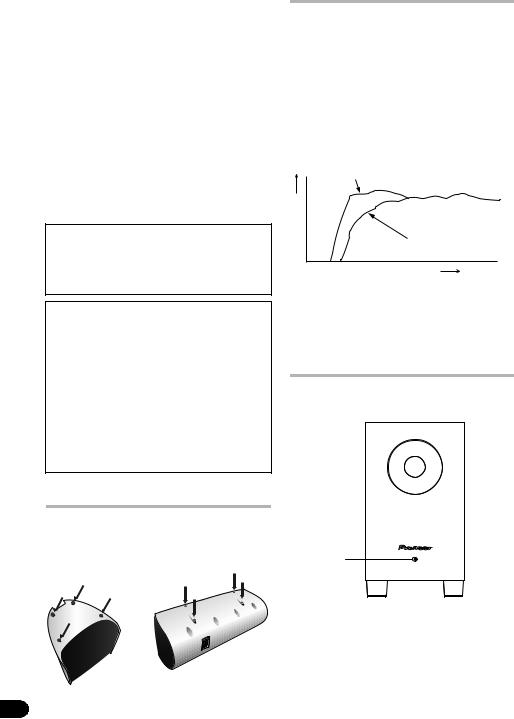
When attaching the speakers to brackets, always use the furnished brackets for wall mounting.
•Do not attach center speaker and subwoofer to the wall or ceiling, as they may cause injury in the event of a fall.
•This speaker system has an impedance of 6 Ω, and should be connected only to an
receiver designed with a load impedance of 6 Ω (the receiver’s speaker output connector should clearly be labeled “6 Ω”).
•The S-11 incorporates autoregression technology to protect the speakers. If the speakers stop emitting noise when receiving too large a signal, turn the volume down on the receiver and wait a few seconds. The protection feature disables itself automatically.
Pioneer is not responsible for any accidents or damage that result from improper installation, misuse or modification of the product, or natural disasters.
Maintenance of external surfaces:
•Clean the surface by wiping with a soft, dry cloth.
•When the surfaces are very dirty, wipe with a soft cloth dipped in some neutral cleanser diluted five or six times with water, and wrung out well, and then wipe again with a dry cloth. Do not use furniture wax or cleaners.
•Never use thinners, benzine, insecticide sprays and other chemicals on or near this unit, since these will corrode the surfaces.
Effective Combination of
Subwoofer and Satellite
Speakers
•When the subwoofer is combined with satellite speakers in a total system, the sound characteristics produced are like those shown in the accompanying graph, depicting the enhancement of the bass frequencies.
This is particularly effective for reproducing ground rumbles and other deep sound effects found in movies.
Satellite speaker + Subwoofer
ponse(dB) |
Only the satellite speaker |
Res |
|
Frequency(Hz)
Connections and Use (S-21W)
Panel facilities
Front panel
Affixing Non-Skid Pads
Apply the accessory non-skid pads to the |
|
bottom surfaces of the front/center/surround |
|
speakers |
1 |
8
En

Rear panel
2
MIN MAX
3
LINE IN
ON  4
4
AUTO STANDBY
ON 


 5
5
POWER
6
AC IN
1Power Indicator
When the power is turned ON, the indicator changes from flashing to steadily lighted blue. In the standby mode, the indicator lights red.
•The power is still supplied even when the power indicator is off. The power plug (interrupter) must be unplugged in order to completely cut the power supply. When not using this product for long periods of time, such as when traveling, unplug the power cord (interrupter) from the power outlet for safety purposes. Failure to do so could lead to fire.
2Volume knob (MIN/MAX)
•Sets the subwoofer volume.
•With this unit, the bass level can be independently set, so do not turn up the bass on the receiver.
•The volume knob is factory set at the MIN position.
3Line Level Input terminal (LINE IN)
4Auto Standby switch (AUTO STANDBY)
•Turning the Auto Standby function on or off.
•The default setting for AUTO STANDBY switch is ON.
Auto standby function
When there is no (or only very weak) input signal for a period of about ten minutes, the power mode automatically changes to standby (power indicator lights red). The power automatically turns on when a signal is input. The auto standby function is deactivated when AUTO STANDBY switch is set to OFF.
•There may be cases where a connected component outputs noise or some other non-audio signal which causes the subwoofer to automatically power on when in Auto Standby mode. If this happens, switch off the Auto Standby mode and switch the subwoofer on/off manually.
5Power switch (POWER)
•Switches the subwoofer between ON and OFF.
6AC IN
•Connect the power cord to a AC socket.
Connection
Before making or changing the connections, switch off the power and disconnect the power cord from the AC outlet.
Line level connection
Supplied RCA plug cord
Rear Panel
Connect the set’s LINE IN terminal to the receiver’s SUBWOOFER PREOUT terminal using the included RCA plug cord.
•When connected to the PREOUT terminal for surround center channel on the receiver, the bass is heard only on the center channel, so it will be insufficient.
Pyccкий Español Nederlands Italiano Deutsch Français English
9
En

Connecting the power cord |
ON |
POWER |
AC IN |
Power Cord |
Connect the power cord for the this unit to the unit’s power connector (AC IN), and the other ends to an AC power supply. When turning on the power, turn on the power to the receiver first, then the power to this unit.
Operation
For details regarding operating part functions, refer to Panel facilities on page 8.
1Turn the POWER switch (5) ON.
•If the unit’s power cord is connected to a switched AC outlet on the receiver and the switch is left ON, the unit can be turned ON/OFF together with the receiver.
•If the unit’s power cord cannot be connected to the receiver, turn the power to the receiver ON before turning the power to the unit ON. When turning the power OFF, turn the power to the unit OFF before turning the power to the receiver OFF.
•Set the cross-over frequency to match that of the speakers actually used.
2Operate the receiver and adjust the volume of the other speakers.
3Adjust the volume of the bass with the volume knob (2).
•Turn the knob slowly from the MIN position.
4Turn the POWER switch (5) OFF.
•The power indicator disappears.
•Do not use the speaker to output distorted sound for long periods of time. This can result in damages to the speaker and poses a potential fire hazard.
Connections and Use (S-11)
Connection
Before making or changing the connections, switch off the power and disconnect the power cord from the AC outlet.
Connecting the speakers
To get the best out of your speakers it is important that you connect them properly to your receiver. Each speaker connection consists of a positive (+) and a negative (–) terminal. These should be matched between the receiver and the speaker.
1Attach one end of the supplied speaker cord to the rear of the each speaker.
•Connect the wire with the colored marker to the red (+) terminal; the plain wire to the black (–) terminal. Press down the spring-loaded tab and insert the wire, as shown below. Release the tab to secure the wire.
Black (–) Red (+) |
Red colored marker |
2Connect the other end of each speaker cord to your receiver.
•To connect, insert the colored wire into the matching positive (colored) terminal and the other wire into the negative (black) terminal. See also the Operating Instructions that came with your receiver.
10
En
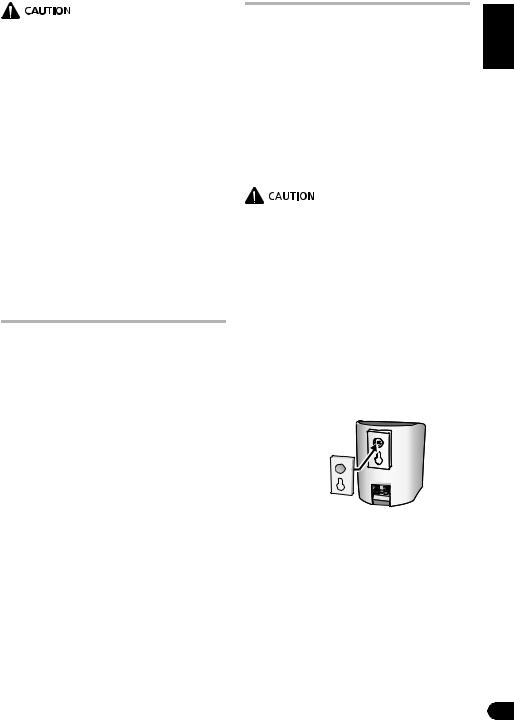
•These speaker terminals carry HAZARDOUS LIVE voltage. To prevent the risk of electric shock when connecting or disconnecting the speaker cords, disconnect the power cord before touching any uninsulated parts.
•After connecting the plugs, pull lightly on the cords to make sure that the ends of the cords are securely connected to the terminals. Poor connections can create noise and interruptions in the sound.
•If the cords’ wires happen to be pushed out of the terminals, allowing the wires to come into contact with each other, it places an excessive additional load on the receiver. This may cause the amp to stop functioning, and may even damage the receiver.
•When using a set of speakers connected to an receiver, you won’t be able to obtain the normal stereo effect if the polarity (+, –) of one of the speakers (left or right) is reversed.
Operation
•Set the receiver’s cross-over frequency at 200 Hz.
Wall-mounting the front and surround speaker system
Attaching the brackets
•When attaching the speakers to brackets, always use the furnished brackets for wall mounting.
•Make sure to tighten the supplied screw as securely as possible when attaching the bracket to the back of the speaker.
•Do not attach brackets to center speaker or subwoofer.
•Use the M5 metric thread screw. Do not use inch thread screw.
Before mounting
•Remember that the speaker system is heavy and that its weight could cause the wood screws to work loose, or the wall material to fail to support it, resulting in the speaker falling. Make sure that the wall on which you intend to mount the speakers is strong enough to support them. Do not mount on plywood or soft surface walls.
•Mounting screws are not supplied. Use screws suitable for the wall material and support the weight of the speaker. If you are unsure of the qualities and strength of the walls, consult a professional for advice.
Screw (supplied)
|
5 mm |
|
|
(3/16 in.) |
|
5 mm (3/16 in.) to 7 mm (9/32 in.) |
10 mm |
|
Mounting screw (not supplied) |
||
(13/32 in.) |
||
|
Pyccкий Español Nederlands Italiano Deutsch Français English
11
En

Specifications
S-21W
Power Amplifier Power Output (Peak) ................................................................................................. |
160 W |
Power Amplifier Power Output (RMS) ....................................................... |
100 W (100 Hz, 4 Ω, THD 10 %) |
Power Amplifier Power Output (FTC).............................................. |
80 W (35 Hz to 500 Hz, 4 Ω, THD 1 %) |
Input (sensitivity at 100 Hz) LINE LEVEL (RCA jack) ......................................................................... |
300 mV |
Cabinet.......................................................................................................................... |
Bass-reflex, floor type |
Speaker.................................................................................................................................. |
16 cm cone type |
Speaker Frequency range .................................................................................................... |
33 Hz to 700 Hz |
Power Requirements |
|
European model........................................................................................ |
AC 220 V to 240 V, 50 Hz/60 Hz |
U.S., Canadian model ....................................................................................................... |
AC 120 V, 60 Hz |
Other model .............................................................................................. |
AC 110 V to 240 V, 50 Hz/60 HZ |
Power Consumption ................................................................................................................................ |
25 W |
Power consumption in standby................................................................................................. |
0.5 W or less |
Outline Dimension....................................................................... |
230 mm (W) x 408 mm (H) x 344 mm (D) |
|
(9 1/16 in.(W) x 16 1/16 in.(H) x 13 17/32 in. in.(D)) |
Weight (without package) .................................................................................................. |
6.5 kg (14 lb 5 oz) |
S-11 |
|
Front speakers / Surround speakers |
|
Enclosure |
|
Front speakers ......................................................... |
Closed-box bookshelf type (magnetically shielded) |
Surround speakers .......................................................................................... |
Closed-box bookshelf type |
System ............................................................................................................................ |
7.7 cm 1-way system |
Speaker................................................................................................................................. |
7.7 cm cone type |
Nominal impedance ................................................................................................................................... |
6 Ω |
Frequency range .................................................................................................................. |
100 Hz to 20 kHz |
Sensitivity................................................................................................................................................. |
82 dB |
Permissible input: maximum input...................................................................................................... |
150 W |
Dimensions .................................................................................. |
106 mm (W) x 116 mm (H) x 106 mm (D) |
|
(4 3/16 in.(W) x 4 9/16 in.(H) x 4 3/16 in.(D)) |
Weight |
|
Front speakers ................................................................................................................ |
0.8 kg (1 lb 12 oz) |
Surround speakers ........................................................................................................... |
0.6 kg (1 lb 5 oz) |
Center speaker |
|
Enclosure..................................................................... |
Closed-box bookshelf type (magnetically shielded) |
System ............................................................................................................................ |
7.7 cm 1-way system |
Speaker................................................................................................................................. |
7.7 cm cone type |
Nominal impedance ................................................................................................................................... |
6 Ω |
Frequency range .................................................................................................................... |
90 Hz to 20 kHz |
Sensitivity................................................................................................................................................. |
83 dB |
Permissible input: maximum input...................................................................................................... |
150 W |
Dimensions .................................................................................. |
270 mm (W) x 100 mm (H) x 106 mm (D) |
|
(10 5/8 in.(W) x 3 15/16 in.(H) x 4 3/16 in.(D)) |
Weight.................................................................................................................................... |
1.0 kg (2 lb 3 oz) |
Specifications and design subject to possible modification without notice, due to improvements.
12
En

Troubleshooting
Incorrect operations are often mistaken for trouble and malfunctions. If you think that there is something wrong with this component, check the points below. Sometimes the trouble may lie in another component. Investigate the other components and electrical appliances being used. If the trouble cannot be rectified even after exercising the checks listed below, ask your nearest PIONEER authorized service center or your dealer to carry out repair work.
S-21W
Symptom |
|
Cause |
|
Remedy |
|
|
|
|
|
No power is being supplied |
• |
Power supply plug is not |
• |
Insert plug securely. |
(Indicator does not light up |
|
correctly inserted. |
|
|
when POWER switch is |
|
|
|
|
turned on) . |
|
|
|
|
|
|
|
|
|
No sound |
• |
Connection of accessory |
• |
Check again and connect |
(Indicator is lit blue) . |
|
RCA plug cord is wrong or |
|
correctly. |
|
|
disconnected. |
|
|
|
• Volume knob is set to MIN. |
• |
Turn clockwise slowly. |
|
|
• |
Input level is too low. |
• Raise the receiver’s output |
|
|
|
|
|
level. |
|
|
|
|
|
Sound is distorted. |
• |
Level is too high. |
• |
Turn the volume knob |
|
|
|
|
counter-clockwise to lower |
|
|
|
|
the level. |
|
• |
Input level is too high. |
• Turn the receiver’s output |
|
|
|
|
|
level (volume, bass control, |
|
|
|
|
bass boost) counter- |
|
|
|
|
clockwise to lower the level. |
|
|
|
|
|
Howling noise occurs. |
• |
No power supplied to the |
• Connect an receiver and |
|
|
|
receiver. |
|
supply power. |
|
• Subwoofer level is set too |
• Place the subwoofer a good |
||
|
|
high. |
|
distance from speakers. |
|
|
|
|
Turn the volume knob |
|
|
|
|
counter-clockwise to lower |
|
|
|
|
the volume. |
|
|
|
|
|
Much noise when listening |
• |
The AM loop antenna or |
• |
Increase the distance |
to AM or FM broadcasts. |
|
the FM indoor antenna is |
|
between the AM or FM |
|
|
close to this unit. |
|
antenna (for indoor use) |
|
|
|
|
and this unit. |
|
|
|
|
|
Pyccкий Español Nederlands Italiano Deutsch Français English
13
En

Symptom |
Cause |
Remedy |
|
|
|
|
|
No sound is produced |
• Unit has entered standby |
• Turn the Auto Standby |
|
(power indicator lights red) |
mode. |
function OFF. |
|
|
|
– When the Auto Standby |
|
Initial sounds of a track |
• The audio signal was input |
||
function is turned ON, if |
|||
can’t be heard. |
when the unit was in the |
no signal (or only a very |
|
|
standby mode. |
weak signal) is input for |
|
|
|
a period of about ten |
|
|
|
minutes, the power |
|
|
|
mode will automatically |
|
|
|
change to standby. |
|
|
|
– Note that when listening |
|
|
|
with the volume set to a |
|
|
|
very low level, the Auto |
|
|
|
Standby function may |
|
|
|
operate, switching the |
|
|
|
unit to the standby |
|
|
|
mode. |
|
|
|
|
S-11
Symptom |
|
Cause |
|
Remedy |
|
|
|
|
|
No sound. |
• |
Incorrect connection of |
• |
Connect correctly. |
|
|
speaker wire. |
• |
Turn on receiver. |
|
• |
Receiver is off. |
• |
Slowly turn up volume. |
|
• |
Volume control is at zero. |
|
|
|
|
|
|
|
Sound is distorted. |
• |
Extreme signal condition. |
• Turn down the receiver’s |
|
|
|
|
|
output level (volume, bass |
|
|
|
|
control, bass boost) to |
|
|
|
|
lower the level. |
|
|
|
|
|
Speakers stop producing |
• |
An excessively large signal |
• |
Turn the volume down to |
sound suddenly. |
|
was input, resulting in the |
|
resume normal speaker |
|
|
operation of the automatic |
|
output. |
|
|
protection circuit. |
|
|
|
|
|
|
|
Published by Pioneer Corporation.
Copyright © 2010 Pioneer Corporation.
All rights reserved.
14
En

English |
|
Français |
Deutsch |
Italiano |
Nederlands |
Español |
Pyccкий |
|
|
|
|
|
|
|
|
15 En
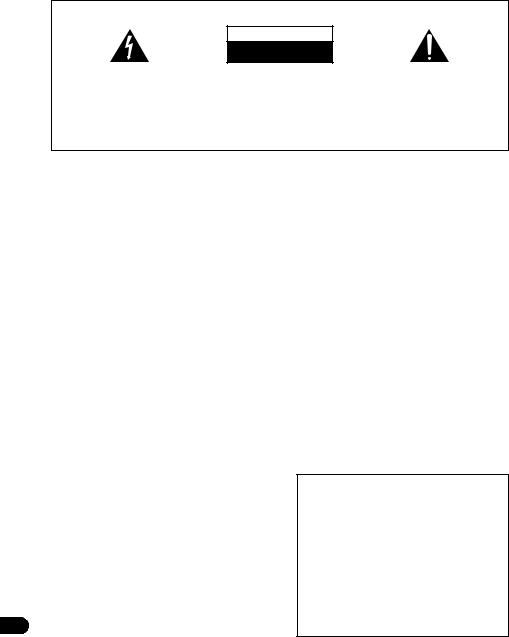
Nous vous remercions pour cet achat d’un produit PIONEER. Nous vous demandons de lire soigneusement ce mode d’emploi; vous serez ainsi à même de faire correctement fonctionner l’appareil. Après avoir bien lu le mode d’emploi, le ranger dans un endroit sûr pour pouvoir s’y référer ultérieurement.
Ce mode d’emploi a été rédigé de manière à être utilisé avec le modèle S-21W ou le S-11. Consultez les sections du manuel qui se rapportent à votre modèle.
IMPORTANT
ATTENTION
DANGER D´ELECTROCUTION
NE PAS OUVRIR
Ce symbole de l’éclair, placé dans un triangle équilatéral, a pour but d’attirer l’attention de l’utilisateur sur la présence, à l’intérieur du coffret de l’appareil, de “tensions dangereuses” non isolées d’une grandeur suffisante pour représenter un risque d’électrocution pour les êtres humains.
ATTENTION :
POUR ÉVITER TOUT RISQUE D’ÉLECTROCUTION, NE PAS ENLEVER LE COUVERCLE (NI LE PANNEAU ARRIÈRE). AUCUNE PIÈCE RÉPARABLE PAR L’UTILISATEUR NE SE TROUVE À L’INTÉRIEUR. CONFIER TOUT ENTRETIEN À UN PERSONNEL QUALIFIÉ UNIQUEMENT.
Ce point d’exclamation, placé dans un triangle équilatéral, a pour but d’attirer l’attention de l’utilisateur sur la présence, dans les documents qui accompagnent l’appareil, d’explications importantes du point de vue de l’exploitation ou de l’entretien.
D3-4-2-1-1_A1_Fr
AVERTISSEMENT
Cet appareil n’est pas étanche. Pour éviter les risques d’incendie et de décharge électrique, ne placez près de lui un récipient rempli d’eau, tel qu’un vase ou un pot de fleurs, et ne l’exposez pas à des gouttes d’eau, des éclaboussures, de la pluie ou de l’humidité.
D3-4-2-1-3_A1_Fr
AVERTISSEMENT
Avant de brancher l’appareil pour la première, lisez attentivement la section suivante.
La tension de l’alimentation électrique disponible varie selon le pays ou la région. Assurez-vous que la tension du secteur de la région où l’appareil sera utilisé correspond à la tension requise (par ex. 230 V ou 120 V), indiquée sur le panneau arrière.
D3-4-2-1-4*_A1_Fr
AVERTISSEMENT
Pour éviter les risques d’incendie, ne placez aucune flamme nue (telle qu’une bougie allumée) sur l’appareil.
D3-4-2-1-7a_A1_Fr
PRÉCAUTION DE VENTILATION
Lors de l’installation du caisson de graves, veillez à laisser un espace suffisant autour de ses parois de manière à améliorer la dissipation de chaleur (au moins 10 cm sur le dessus, 10 cm à
2 l’arrière et 10 cm de chaque côté.)
AVERTISSEMENT
Les fentes et ouvertures du coffret sont prévues pour la ventilation, pour assurer un fonctionnement stable de l’appareil et pour éviter sa surchauffe. Pour éviter les risques d’incendie, ne bouchez jamais les ouvertures et ne les recouvrez pas d’objets, tels que journaux, nappes ou rideaux, et n’utilisez pas l’appareil posé sur un tapis épais ou un lit.
D3-4-2-1-7b*_A1_Fr
Milieu de fonctionnement
Température et humidité du milieu de fonctionnement :
De +5 °C à +35 °C (de +41 °F à +95 °F) ; Humidité relative inférieure à 85 % (orifices de ventilation non obstrués) N’installez pas l’appareil dans un endroit mal ventilé ou un lieu soumis à une forte humidité ou en plein soleil (ou à une forte lumière artificielle).
D3-4-2-1-7c*_A1_Fr
Si la fiche d’alimentation secteur de cet appareil ne convient pas à la prise secteur à utiliser, la fiche doit être remplacée par une appropriée. Ce remplacement et la fixation d’une fiche secteur sur le cordon d’alimentation de cet appareil doivent être effectués par un personnel de service qualifié. En cas de branchement sur une prise secteur, la fiche de coupure peut provoquer une sérieuse décharge électrique. Assurez-vous qu’elle est éliminée correctement après sa dépose.
L’appareil doit être déconnecté en débranchant sa fiche secteur au niveau de la prise murale si vous prévoyez une période prolongée de non utilisation (par exemple avant un départ en vacances).
D3-4-2-2-1a_A1_Fr
Fr

ATTENTION
L’interrupteur POWER de cet appareil ne coupe pas complètement celui-ci de sa prise secteur. Comme le cordon d’alimentation fait office de dispositif de déconnexion du secteur, il devra être débranché au niveau de la prise secteur pour que l’appareil soit complètement hors tension. Par conséquent, veillez à installer l’appareil de telle manière que son cordon d’alimentation puisse être facilement débranché de la prise secteur en cas d’accident. Pour éviter tout risque d’incendie, le cordon d’alimentation sera débranché au niveau de la prise secteur si vous prévoyez une période prolongée de non utilisation (par exemple avant un départ en vacances).
D3-4-2-2-2a*_A1_Fr
Cet appareil numérique de la Classe B est conforme à la norme NMB-003 du Canada.
D8-10-1-3_A1_Fr
Ce produit est destiné à une utilisation domestique générale. Toute panne due à une utilisation autre qu'à des fins privées (comme une utilisation à des fins commerciales dans un restaurant, dans un autocar ou sur un bateau) et qui nécessite une réparation sera aux frais du client, même pendant la période de garantie.
K041_A1_Fr
NOTE IMPORTANTE SUR LE CABLE D’ALIMENTATION
Tenir le câble d’alimentation par la fiche. Ne pas débrancher la prise en tirant sur le câble et ne pas toucher le câble avec les mains mouillées. Cela risque de provoquer un court-circuit ou un choc électrique.
ATTENTION:
Ne montez pas et ne vous asseyez pas sur l’appareil. Soyez spécialement prudent sides enfants sont à proximité, car l’appareil pourraitêtre endommagé et causer des blessures en tombant.
Pour modèle européen uniquement
Si vous souhaitez vous débarrasser de cet appareil, ne le mettez pas à la poubelle avec vos ordures ménagères. Il existe un système de collecte séparé pour les appareils électroniques usagés, qui doivent être récupérés, traités et recyclés conformément à la législation.
Les habitants des états membres de l’UE, de Suisse et de Norvège peuvent retourner gratuitement leurs appareils électroniques usagés aux centres de collecte agréés ou à un détaillant (si vous rachetez un appareil similaire neuf).
Dans les pays qui ne sont pas mentionnés ci-dessus, veuillez contacter les autorités locales pour savoir comment vous pouvez vous débarrasser de vos appareils.
Vous garantirez ainsi que les appareils dont vous vous débarrassez sont correctement récupérés, traités et recyclés et préviendrez de cette façon les impacts néfastes possibles sur l’environnement et la santé humaine.
K058b_A1_Fr
Pyccкий Español Nederlands Italiano Deutsch Français English
3
Fr
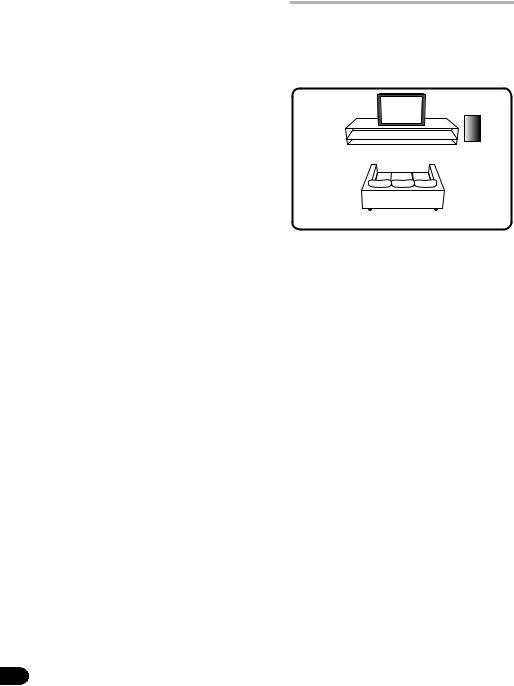
Sommaire |
Installation |
Caractéristiques .................................. |
4 |
Articles accessoires............................. |
4 |
Installation .......................................... |
4 |
Branchements et utilisation (S-21W) ... |
7 |
Branchements et utilisation (S-11).... |
9 |
Fiche technique................................. |
11 |
Guide de dépannage ........................ |
12 |
Caractéristiques
S-21W
•Forte puissance de 160 W (crête)
•Design compact et réponse étendue dans le grave
•Technologie Phase Control
S-11
•Puissance maximum de 150W
•Coffret de forme arrondie
•Technologie Phase Control
Articles accessoires
S-21W
•Câble à fiche RCA (3 m) x 1
•Cordon d’alimentation
S-11
•Cordons d’enceinte (4 m) x 3
•Cordons d’enceinte (10 m) x 2
•Coussinets antidérapants x 20
•Appliques pour montage mural x 4
•Vis (M5) x 4
Articles pour S-21W et S-11
•Carte de garantie
•Mode d’emploi (ce document)
4
Installation des enceintes
• Comme indiqué sur cette illustration, si des enceintes d’ambiance (surround) sont installées derrière la position d’écoute, vous pouvez bénéficier d’un véritable son surround 5,1 canaux.
1 3
2 4
6 |
7 |
5
1Enceinte avant gauche
2Enceinte centrale
3Enceinte avant droite
4Caisson de graves
5Position d’écoute
6Enceinte surround gauche
7Enceinte surround droite
•Le caisson de graves et les enceintes surround de ce système ne peuvent pas être utilisés près d’un téléviseur ou d’un moniteur couleur à tube cathodique. Si vous utilisez ce genre de téléviseur ou de moniteur couleur à tube cathodique, installez les enceintes à l’écart de l’écran. Tout dispositif susceptible d’être influencé par le magnétisme (lecteur de disquette, magnétocassette, lecteur vidéo, etc.) doit être maintenu à l’écart du caisson de graves et des enceintes surround.
Caisson de graves (S-21W)
•Lors d’un déplacement du caisson de graves, évitez de toucher la surface du fond sur laquelle est situé le haut-parleur.
•Orientez la face avant du caisson de graves vers la position d’écoute.
•Le caisson de graves restitue les basses en monophonie, profitant du fait que l’oreille humaine n’est guère sensible pour localiser les sons graves. Pour cette raison, ce caisson peut être installé pratiquement n’importe où. Toutefois, s’il est installé trop loin, le son des autres enceintes risque de ne plus être naturel.
Fr

Le degré de l’effet des graves peut s’ajuster en éloignant ou en rapprochant le caisson par rapport au mur.
Enceintes satellites (S-11)
•Les étiquettes prévues à l’arrière de chaque enceinte indiquent si elles sont destinées à servir comme enceintes avant ou d’ambiance (surround).
•Les enceintes installées à gauche et à droite doivent être distantes d’environ 1,8 m à 2,7 m. Elles doivent être placées à égale distance du téléviseur et à la même hauteur par rapport au sol.
•Vous pouvez acheter des supports d’enceinte en option qui faciliteront le placement des enceintes surround à la hauteur des oreilles de l’auditeur ou légèrement au-dessus.
•L’effet d’ambiance diminuera si les enceintes surround sont placées très loin de la position d’écoute.
•Les enceintes avant et l’enceinte centrale fournies avec ce système sont conçues pour fonctionner à proximité d’un téléviseur ou d’un moniteur couleur à tube cathodique. Cependant, si une distorsion des couleurs est constatée par suite de cette installation, coupez l’alimentation du téléviseur ou du moniteur couleur à tube cathodique pendant 15 à 30 minutes, puis remettez-le sous tension. Le dispositif de démagnétisation incorporé au téléviseur ou au moniteur couleur à tube cathodique devrait corriger l’effet des enceintes sur l’image du téléviseur. Si la distorsion des couleurs n’est pas corrigée, éloignez les enceintes par rapport à l’écran. Si des aimants ou des dispositifs produisant un champ magnétique sont installés à proximité, une interaction avec les enceintes peut provoquer une distorsion des couleurs sur un téléviseur ou un moniteur couleur à tube cathodique.
 ATTENTION
ATTENTION
•Installez l’enceinte centrale en dessous du téléviseur, de sorte que le son du canal central semble provenir de l’écran du téléviseur.
•Si vous installez l‘enceinte centrale sur le téléviseur, veillez à l’immobiliser avec un cordon ou par un moyen approprié. Sinon, l’enceinte risquerait de tomber du fait de chocs extérieurs à l’appareil, comme lors d’un séisme ; vous pourriez mettre en danger les personnes à proximité ou l’enceinte pourrait être endommagée.
Précautions d’installation
•Ne placez pas d’objets pesants ou volumineux sur le dessus des enceintes. Ceci pourrait provoquer leur chute,entraînant des dégâts ou des blessures.
•Ne placez pas l’enceinte sur une surface instable, car elle pourrait tomber et provoquer des dégâts ou des blessures.
•Mettez votre système audiovisuel hors tension et débranchez-le, puis consultez le mode d’emploi avant de brancher des composants. Prenez soin d’utiliser correctement les cordons de raccordement.
•Ne montez pas et ne vous asseyez pas sur les enceintes et ne laissez pas des enfants jouer avec celles-ci. Ceci pourrait provoquer leur chute,entraînant des dégâts ou des blessures.
•Installez le caisson de graves dans un endroit bien ventilé où il ne sera pas soumis à de l’humidité ou à des températures excessives.
•Ne placez pas le caisson de graves à proximité d’un radiateur ou d’un autre appareil de chauffage et ne l’exposez pas aux rayons directs du soleil, car cela risquerait d’endommager le coffret ou les composants internes. Ne le placez pas dans un endroit excessivement poussiéreux ou humide, car ceci pourrait provoquer des anomalies de fonctionnement ou une panne. (Evitez de le placer sur une table de cuisine ou à un autre endroit où il serait soumis à de la chaleur, de la vapeur ou de la suie.)
•Ne placez pas le caisson de graves à proximité d’un appareil, tel qu’un magnétophone, susceptible d’être affecté par les champs magnétiques.
•Ne posez pas de tasses, verres ou autres récipients contenant un liquide sur le dessus des appareils, car ceux-ci pourraient être endommagés si du liquide devait s’y infiltrer.
•L’emplacement d’installation choisi doit être la surface d’un plancher solide. Evitez de poser le caisson de graves sur un tapis à longs poils, car ils pourraient toucher le diaphragme et provoquer une distorsion des sons.
•Veillez à installer le caisson de graves à l’écart du câble d’antenne du récepteur, car des parasites peuvent être provoqués par une installation proche du câble d’antenne. Dans ce cas, utilisez le caisson de graves à une position éloignée de
Pyccкий Español Nederlands Italiano Deutsch Français English
5
Fr

l’antenne et du câble d’antenne, ou si la reproduction de basses supplémentaires n’est pas nécessaire, coupez l’alimentation du caisson de graves.
•La grille avant des enceintes avant, centrale et surround ne peut pas être enlevée. N’essayez pas de l’enlever en forçant car elle en serait endommagée.
•Si vous installez les enceintes avant et surround sur une paroi, assurez-vous que celle-ci soit suffisamment résistante pour supporter leur poids.
•N’attachez pas l’enceinte centrale et le caisson de graves sur un mur ou au plafond car ils pourraient occasionner des blessures en cas de chute.
•Cette enceinte acoustique a une impédance de 6 Ω et on ne la raccordera
donc qu’à un récepteur conçu pour une impédance de charge de 6 Ω (le connecteur de sortie de haut-parleur du
récepteur doit clairement porter la mention “6 Ω”).
•La S-11 incorpore une technologie dite d’autorégression afin de protéger les hautparleurs. Si les enceintes cessent d’émettre des sons à la réception d’un signal trop puissant, réduisez le volume sur le récepteur et attendez quelques secondes. Cette fonction de protection se désactive automatiquement.
Pioneer n’assume aucune responsabilité en cas d’accidents ou de dégâts, résultant d’une installation inappropriée, d’une erreur d’utilisation, d’une altération du produit ou de catastrophes naturelles.
Entretien des surfaces externes
•Nettoyez les surfaces avec un linge doux et sec.
•Si les surfaces sont très sales, utilisez un linge doux et un produit détergent neutre dilué dans cinq ou six fois son volume d’eau. Tordez bien le linge avant de nettoyer les surfaces. Essuyez-les ensuite avec un linge sec. N’utilisez pas de cire ou de détergent pour mobilier.
•N’utilisez jamais de diluant, benzine, bombe insecticide et autres produits chimiques à proximité de cette enceinte, car ces produits détérioreraient la finition de sa surface.
6
Fixation des coussinets antidérapants
Placez les coussinets antidérapants fournis sur le fond des enceintes avant, centrale et surround.
Combinaison efficace du caisson de graves et d’enceintes satellites
•Si le caisson de graves est associé à des enceintes satellites pour former un ensemble, les caractéristiques sonores obtenues ressembleront aux paramètres du schéma ci-après qui illustre la mise en valeur des basses fréquences.
Cette combinaison est particulèrement efficace pour restituer les grondements du sol et autres effets sonores profonds, utilisés dans les films.
Enceinte satellite + Caisson de graves
(dB) |
|
Réponse |
Enceinte satellite seule |
|
Fréquence (Hz) 
Fr
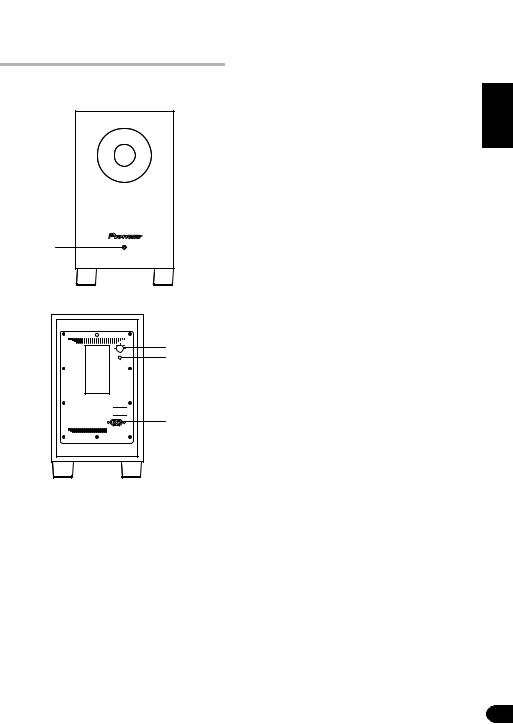
Branchements et utilisation (S-21W)
Organes des panneaux
Panneau avant
1
Panneau arrière
2
MIN MAX
3
LINE IN
ON  4
4
AUTO STANDBY
ON 


 5
5
POWER
6
AC IN
1Voyant d’alimentation
Quand l’appareil est mis sous tension, ce voyant d’abord clignotant reste allumé en bleu clair. En mode veille, le voyant est allumé en rouge.
 ATTENTION
ATTENTION
•Le courant continue d’être fourni même quand le voyant d’alimentation est éteint. La prise de courant (interrupteur) doit être débranchée pour que l’alimentation électrique soit complètement coupée. Si vous prévoyez une longue période d’inutilisation de l’appareil, comme dans le cas d’un voyage, débranchez la prise de courant (interrupteur) au niveau de la prise secteur par souci de sécurité. Vous éviterez ainsi un risque d’incendie.
2Bouton de volume (MIN/MAX)
•Il permet d’ajuster le volume du caisson de graves.
•Avec cet appareil, le niveau des basses peut être réglé indépendamment et il n’est donc pas nécessaire d’élever le niveau des basses sur le récepteur.
 ATTENTION
ATTENTION
•Le bouton de volume est réglé en usine à la position MIN.
3Borne d’entrée du niveau de ligne (LINE IN)
4Interrupteur de veille automatique (AUTO STANDBY)
•Il commande la mise en/hors service (ON/ OFF) de la fonction de veille automatique.
 ATTENTION
ATTENTION
•Par défaut, l’interrupteur AUTO STANDBY est en service (ON).
Fonction Veille automatique
Si aucun signal (ou seulement un signal faible) n’est émis pendant une dizaine de minutes, le mode d’alimentation passe automatiquement au mode veille (le voyant d’alimentation s’allume en rouge). L’alimentation est automatiquement rétablie dès qu’un signal est détecté. La fonction Veille automatique est désactivée quand l’interrupteur AUTO STANDBY est réglé sur OFF (désactivé).
 ATTENTION
ATTENTION
•Des cas peuvent se présenter où un composant raccordé émet des parasites ou d’autres signaux non-audio qui provoquent une remise sous tension du caisson de graves alors qu’il est en mode de veille automatique. Dans ce cas, désactivez le mode de veille automatique et mettez le caisson de graves manuellement en service ou hors service.
5Interrupteur d’alimentation (POWER)
•Il commande la mise sous/hors tension (ON/OFF) du caisson de graves.
6Connecteur d’alimentation (AC IN)
•Branchez le cordon d’alimentation sur une prise du secteur.
Pyccкий Español Nederlands Italiano Deutsch Français English
7
Fr
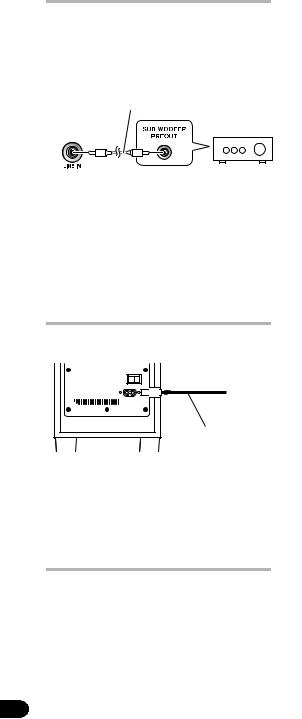
Connexion
Avant d’effectuer ou de changer les connexions, coupez l’alimentation et débranchez le cordon d’alimentation au niveau de la prise du secteur.
Connexion de niveau de ligne
Cordon à fiche RCA fourni
Panneau arrière
Raccordez la borne LINE IN de l’appareil sur la borne SUBWOOFER PREOUT du récepteur au moyen du cordon à fiche RCA fourni.
 ATTENTION
ATTENTION
•En cas d’une connexion sur la borne PREOUT pour la voie centrale surround sur le récepteur, les graves ne seront perçus que sur la voie centrale, ce qui laissera à désirer.
Branchement du cordon |
d’alimentation |
ON |
POWER |
AC IN |
Cordon d’alimentation |
Branchez le cordon d’alimentation destiné à cet appareil dans le connecteur d’alimentation (AC IN) de celui-ci et l’autre bout du cordon dans une prise secteur. Mettez d’abord le récepteur sous tension, puis alimentez cet appareil.
1Allumez (ON) l’interrupteur d’alimentation POWER (5).
•Si le cordon d’alimentation est branché sur une prise secteur commutée du récepteur et que l’interrupteur est laissé activé (ON), cet appareil pourra être mis sous/hors tension en même temps que le récepteur.
•Si le cordon d’alimentation de l’appareil ne peut pas être branché sur le récepteur, mettez d’abord le récepteur sous tension, puis allumez cet appareil. Lors de la mise hors tension, mettez cet appareil hors tension avant de couper l’alimentation du récepteur.
•Réglez la fréquence de recouvrement pour convenir à celle des enceintes utilisées.
2Faites fonctionner le récepteur et ajustez le volume des autres hautparleurs.
3Ajustez le volume des graves par le bouton de volume (2).
•Tournez lentement le bouton à partir de la position MIN.
4Eteignez (OFF) l’interrupteur d’alimentation POWER (5).
•Le voyant d’alimentation disparaît.
 ATTENTION
ATTENTION
•N’utilisez pas l’enceinte pour produire des sons distordus pendant une longue période. Ceci pourrait endommager l’enceinte et présenter un risque d’incendie.
Fonctionnement
Pour des détails sur les fonctions des commandes, reportez-vous à Organes des panneaux la page 7.
8
Fr
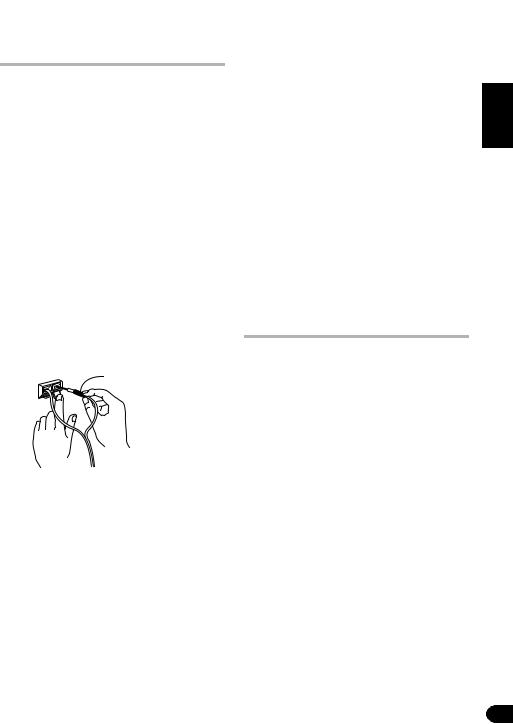
Branchements et utilisation (S-11)
Connexion
Avant d’effectuer ou de changer les connexions, coupez l’alimentation et débranchez le cordon d’alimentation au niveau de la prise du secteur.
Connexion des enceintes
Pour que les enceintes fonctionnent de façon optimale, elles doivent être raccordées correctement au récepteur. Chaque enceinte comprend une borne positive (+) et une négative (–). Ces bornes doivent correspondre sur le récepteur et les enceintes.
1Branchez une extrémité du cordon d’enceinte fourni sur l’arrière de chaque enceinte.
•Branchez le fil au repère coloré sur la borne rouge (+) et le fil ordinaire sur la borne noire (–). Enfoncez le taquet à ressort et insérer le fil comme illustré cidessous. Relâchez le taquet pour immobiliser le fil.
Noir (–) |
Rouge (+) |
Repère de couleur rouge |
2Branchez l’autre extrémité de chaque cordon d’enceinte sur votre récepteur.
•Pour la connexion, insérez le fil coloré dans la borne positive (colorée) correspondante et l’autre fil dans la borne négative (noire). Consultez aussi le mode d’emploi fourni avec votre récepteur.
 ATTENTION
ATTENTION
•Les bornes des enceintes sont sous une tension ACTIVE DANGEREUSE. Pour éviter tout risque de décharge électrique lors du branchement et du débranchement des cordons d’enceinte, débranchez le cordon d’alimentation avant de toucher des parties non isolées.
•Après avoir branché les fiches, tirez légèrement sur celles-ci pour vous assurer que leur extrémité est parfaitement immobilisée par les bornes. De mauvaises connexions sont la source de parasites, voire d’interruptions des sons.
•Si les fils des cordons ressortent des bornes et s’ils entrent en contact mutuellement, le récepteur subira une forte charge supplémentaire. Ceci peut obliger l’amplificateur à s’arrêter et peut même endommager le récepteur.
•A l’emploi d’un jeu d’enceintes raccordé à un récepteur, si la polarité (+, –) d’une des enceintes (gauche ou droite) est inversée, vous n’obtiendrez pas un effet stéréophonique normal.
Fonctionnement
•Réglez la fréquence de recouvrement du récepteur sur 200 Hz.
Pyccкий Español Nederlands Italiano Deutsch Français English
9
Fr

Fixation des enceintes avant et surround sur un mur
Fixation des appliques
•Lors de la fixation d’une applique sur le dos de l’enceinte, veillez à serrer la vis fournie aussi fermement que possible.
•Ne fixez pas des appliques sur l’enceinte centrale ou le caisson de graves.
 ATTENTION
ATTENTION
•Utilisez la vis à filetage métrique M5. N’utilisez pas une vis à filetage en pouce.
Avant la fixation
•Sachez que les enceintes sont pesantes ; elles risquent donc de tomber si les vis à bois se détachent du fait de leur poids ou si le matériau de la paroi n’est pas assez résistant. Assurez-vous que le mur sur lequel vous voulez fixer les enceintes est assez résistant pour les supporter. Ne fixez pas les enceintes sur du contreplaqué ou une surface peu résistante.
•Les vis de fixation ne sont pas fournies. Choisissez les vis en fonction du matériau de la paroi et du poids des enceintes. Si vous hésitez au sujet des propriétés et de la résistance des parois, consultez un professionnel.
Vis (fournie)

 5 mm
5 mm
De 5 mm à 7 mm |
10 mm |
|
Vis de fixation (non fournie) |
||
|
10
Fr

Fiche technique
S-21W
Puissance de sortie d’ampli de puissance (Crête) ............................................................................. |
160 W |
Puissance de sortie d’ampli de puissance (Efficace)............................... |
100 W (100 Hz, 4 Ω, THD 10 %) |
Puissance de sortie d’ampli de puissance (FTC) ............................. |
80 W (35 Hz à 500 Hz, 4 Ω, THD 1 %) |
Entrée (sensibilité à 100 Hz) LINE LEVEL (prise RCA) ...................................................................... |
300 mV |
Coffret ............................................................................................................. |
Basse reflex, de type downfire |
Haut-parleur ............................................................................................................................ |
Cône de 16 cm |
Plage de fréquence d’enceinte......................................................................................... |
De 33 Hz à 700 Hz |
Alimentation électrique |
|
Modèle européen............................................................................... |
Secteur 220 V à 240 V, 50 Hz/60 Hz |
Modèle américain, canadien .................................................................................... |
Secteur 120 V, 60 Hz |
Consommation......................................................................................................................................... |
25 W |
Consommation en mode Veille............................................................................................. |
0,5 W ou moins |
Dimensions extérieures ................................................................ |
230 mm (L) x 408 mm (H) x 344 mm (P) |
Poids (sans emballage).......................................................................................................................... |
6,5 kg |
S-11 |
|
Enceintes avant / Enceintes surround |
|
Coffret |
|
Enceintes avant.............................................................................. |
Satellite clos à blindage magnétique |
Enceintes surround ................................................................................................................ |
Satellite clos |
Système ..................................................................................................................................... |
7,7 cm, 1 voie |
Haut-parleur ........................................................................................................................... |
Cône de 7,7 cm |
Impédance nominale................................................................................................................................. |
6 Ω |
Plage de fréquence.......................................................................................................... |
De 100 Hz à 20 kHz |
Sensibilité ................................................................................................................................................ |
82 dB |
Puissance admissible : puissance maximum..................................................................................... |
150 W |
Dimensions .................................................................................... |
106 mm (L) x 116 mm (H) x 106 mm (P) |
Poids |
|
Enceintes avant................................................................................................................................... |
0,8 kg |
Enceintes surround ............................................................................................................................ |
0,6 kg |
Enceinte centrale |
|
Coffret .............................................................................................. |
Enceinte close à blindage magnétique |
Système ..................................................................................................................................... |
7,7 cm, 1 voie |
Haut-parleur ........................................................................................................................... |
Cône de 7,7 cm |
Impédance nominale................................................................................................................................. |
6 Ω |
Plage de fréquence............................................................................................................ |
De 90 Hz à 20 kHz |
Sensibilité ................................................................................................................................................ |
83 dB |
Puissance admissible : puissance maximum..................................................................................... |
150 W |
Dimensions .................................................................................... |
270 mm (L) x 100 mm (H) x 106 mm (P) |
Poids ........................................................................................................................................................ |
1,0 kg |
Spécifications et design sous réserve de modifications sans préavis en raison d’améliorations éventuelles.
Pyccкий Español Nederlands Italiano Deutsch Français English
11
Fr

Guide de dépannage
Il arrive souvent que des anomalies de fonctionnement ou des problèmes apparents soient dus à de simples erreurs de manipulation. Si ce composant semble ne pas fonctionner correctement, contrôlez les points suivants. Parfois un autre élément de la chaîne est à l’origine du problème. Examinez les autres composants et les appareils électriques en cours d’utilisation. Si vous ne parvenez pas à porter remède à la difficulté en dépit des vérifications proposées sur la liste ci-dessous, demandez au centre de service agréé PIONEER le plus proche ou à votre revendeur d’effectuer les réparations.
S-21W
Symptôme |
|
Cause |
|
Correction |
|
|
|
|
|
L’alimentation n’est pas |
• |
Le cordon d’alimentation |
• |
Branchez correctement le |
fournie. |
|
n’est pas branché |
|
cordon d’alimentation. |
(le voyant d’alimentation ne |
|
correctement. |
|
|
|
|
|
|
|
s’allume pas lorsque |
|
|
|
|
l’interrupteur POWER est |
|
|
|
|
enfoncé). |
|
|
|
|
|
|
|
|
|
Pas de son |
• |
La connexion du cordon à |
• |
Vérifiez les raccordements |
(Le voyant s’est allumé en |
|
fiche RCA fourni comme |
|
et connectez correctement. |
bleu.) |
|
accessoire est erronée ou |
|
|
|
le cordon est débranché. |
|
|
|
|
|
|
|
|
|
• Le bouton de volume est |
• |
Tournez lentement ce |
|
|
|
réglé sur MIN. |
|
bouton dans le sens |
|
|
|
|
horaire. |
|
• Le niveau d’entrée est trop |
• Élevez le niveau de sortie |
||
|
|
faible. |
|
du récepteur. |
|
|
|
|
|
Le son est distordu. |
• |
Le niveau est trop élevé. |
• |
Tournez le bouton de |
|
|
|
|
volume dans le sens |
|
|
|
|
antihoraire pour baisser le |
|
|
|
|
niveau. |
|
• Le niveau d’entrée est trop |
• Tournez les commandes de |
||
|
|
élevé. |
|
réglage du niveau de sortie |
|
|
|
|
du récepteur (volume, |
|
|
|
|
réglage grave, |
|
|
|
|
renforcement des basses) |
|
|
|
|
dans le sens antihoraire |
|
|
|
|
pour baisser le niveau. |
|
|
|
|
|
Un bruit élevé se fait |
• |
L’amplificateur n’est pas |
• |
Connectez l’amplificateur |
entendre. |
|
sous tension. |
|
et mettez-le sous tension. |
|
• Le niveau du caisson de |
• Placez le caisson de graves |
||
|
|
graves est trop élevé. |
|
à une bonne distance des |
|
|
|
|
autres enceintes. Tournez |
|
|
|
|
le bouton de volume dans |
|
|
|
|
le sens antihoraire pour |
|
|
|
|
baisser le niveau. |
|
|
|
|
|
Nombreux parasites lors |
• |
L’antenne cadre AM ou |
• |
Augmentez la distance |
d’écoute d’émissions AM |
|
l’antenne intérieure FM est |
|
entre l’antenne AM ou FM |
ou FM. |
|
proche de cet appareil. |
|
(pour usage intérieur) et cet |
|
|
|
appareil. |
|
|
|
|
|
|
|
|
|
|
|
12
Fr

Symptôme |
Cause |
Correction |
|
|
|
|
|
Aucun son n’est produit (le |
• L’appareil s’est placé en |
• Désactivez la fonction |
|
voyant d’alimentation est |
mode veille. |
Veille automatique. |
|
allumé en rouge) |
|
– Lorsque la fonction |
|
|
|
Veille automatique est |
|
Les premiers sons d’une |
• Les signaux audio ont été |
||
en service (ON), le mode |
|||
plage ne sont pas audibles. |
fournis alors que l’appareil |
d’alimentation passe |
|
|
était en mode Veille. |
automatiquement au |
|
|
|
mode veille si aucun |
|
|
|
signal (ou seulement un |
|
|
|
signal très faible) n’est |
|
|
|
fourni pendant une |
|
|
|
dizaine de minutes. |
|
|
|
– Sachez que, si l’écoute |
|
|
|
se fait à un niveau de |
|
|
|
volume très faible, la |
|
|
|
fonction Veille |
|
|
|
automatique peut agir et |
|
|
|
placer l’appareil en |
|
|
|
mode Veille. |
|
|
|
|
S-11
Symptôme |
|
Cause |
|
Correction |
|
|
|
|
|
Pas de son. |
• |
Connexion défectueuse du |
• |
Effectuez correctement la |
|
|
fil d’enceinte. |
|
connexion. |
|
• Le récepteur est hors |
• Mettez le récepteur sous |
||
|
|
tension. |
|
tension. |
|
• |
La commande de volume |
• Élevez lentement le volume. |
|
|
|
est réglée sur zéro. |
|
|
|
|
|
|
|
Le son est distordu. |
• |
Mauvaise condition des |
• Tournez les commandes du |
|
|
|
signaux. |
|
niveau de sortie du |
|
|
|
|
récepteur (volume, réglage |
|
|
|
|
grave, renforcement des |
|
|
|
|
basses) dans le sens |
|
|
|
|
antihoraire pour baisser le |
|
|
|
|
niveau. |
|
|
|
|
|
Les enceintes cessent |
• |
Un signal extrêmement |
• |
Réduisez le volume pour |
subitement de produire des |
|
puissant a été fourni, ce |
|
revenir à une puissance de |
sons. |
|
qui a déclenché le |
|
sortie d’amplificateur |
|
fonctionnement du circuit |
|
normale. |
|
|
|
|
||
|
|
de protection |
|
|
|
|
automatique. |
|
|
|
|
|
|
|
Publication de Pioneer Corporation. © 2010 Pioneer Corporation.
Tous droits de reproduction et de traduction réservés.
Pyccкий Español Nederlands Italiano Deutsch Français English
13
Fr
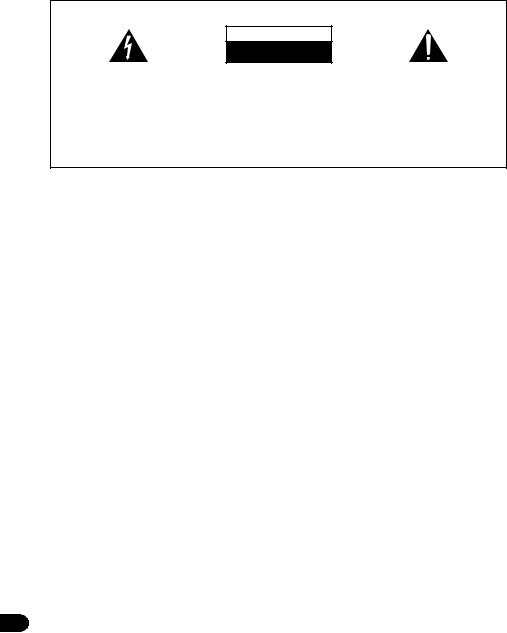
Wir danken Ihnen für den Kauf dieses Pioneer-Produkts. Lesen Sie sich bitte diese Bedienungsanleitung durch. Dann wissen Sie, wie Sie Ihr Gerät richtig bedienen. Bewahren Sie sie an einem sicheren Platz auf, um auch zukünftig nachschlagen zu können.
Diese Bedienungsanleitung gilt gleichermaßen für die beiden Modelle S-21W und S-11. Bitte beziehen Sie sich jeweils auf diejenigen Abschnitte der Anleitung, die speziell für Ihr Modell vorgesehen sind.
WICHTIG
Das Blitzsymbol in einem Dreieck weist den Benutzer darauf hin, dass eine Berührungsgefahr mit nicht isolierten Teilen im Geräteinneren, die eine gefährliche Spannung führen, besteht. Die Spannung kann so hoch sein, dass sie die Gefahr eines elektrischen Schlages birgt.
CAUTION
RISK OF ELECTRIC SHOCK
DO NOT OPEN
ACHTUNG:
UM SICH NICHT DER GEFAHR EINES ELEKTRISCHEN SCHLAGES AUSZUSETZEN, DÜRFEN SIE NICHT DEN DECKEL (ODER DIE RÜCKSEITE) ENTFERNEN. IM GERÄTEINNEREN BEFINDEN SICH KEINE VOM BENUTZER REPARIERBAREN TEILE. ÜBERLASSEN SIE REPARATUREN DEM QUALIFIZIERTEN KUNDENDIENST.
Ein Ausrufezeichen in einem Dreieck weist den Benutzer auf wichtige Bedienungsund Wartungsanweisungen in den Dokumenten hin, die dem Gerät beiliegen.
D3-4-2-1-1_A1_De
WARNUNG
Dieses Gerät ist nicht wasserdicht. Zur Vermeidung der Gefahr von Brand und Stromschlag keine Behälter mit Flüssigkeiten (z.B. Blumenvasen und -töpfe) in die Nähe des Gerätes bringen und dieses vor Tropfwasser, Spritzwasser, Regen und Nässe schützen.
D3-4-2-1-3_A1_De
WARNUNG
Vor dem erstmaligen Anschluss des Gerätes an das Stromnetz bitte den folgenden Hinweis sorgfältig beachten.
Die Netzspannung ist je nach Land verschieden. Vor der Inbetriebnahme des Gerätes sicherstellen, dass die örtliche Netzspannung mit der auf dem Typenschild an der Rückwand des Gerätes angegebenen Nennspannung (z.B. 230 V oder 120 V) übereinstimmt.
D3-4-2-1-4*_A1_De
WARNUNG
Keine Quellen offener Flammen (z.B. eine brennende Kerze) auf dieses Gerät stellen.
D3-4-2-1-7a_A1_De
VORSICHTSHINWEIS ZUR BELÜFTUNG
Bei der Aufstellung des Subwoofers muss für einen ausreichenden Freiraum gesorgt werden, um eine einwandfreie Wärmeabfuhr zu gewährleisten (mindestens 10 cm oberhalb des Subwoofers, 10 cm hinter dem Subwoofer und jeweils 10 cm an beiden Seiten).
WARNUNG
Im Gerätegehäuse sind Ventilationsschlitze und andere Öffnungen vorgesehen, die dazu dienen, eine Überhitzung des Gerätes zu verhindern und einen zuverlässigen Betrieb zu gewährleisten. Um Brandgefahr auszuschließen, dürfen diese Öffnungen auf keinen Fall blockiert oder mit Gegenständen (z.B. Zeitungen, Tischdecken und Gardinen) abgedeckt werden, und das Gerät darf beim Betrieb nicht auf einem dicken Teppich oder Bett aufgestellt sein.
D3-4-2-1-7b*_A1_De
2
De
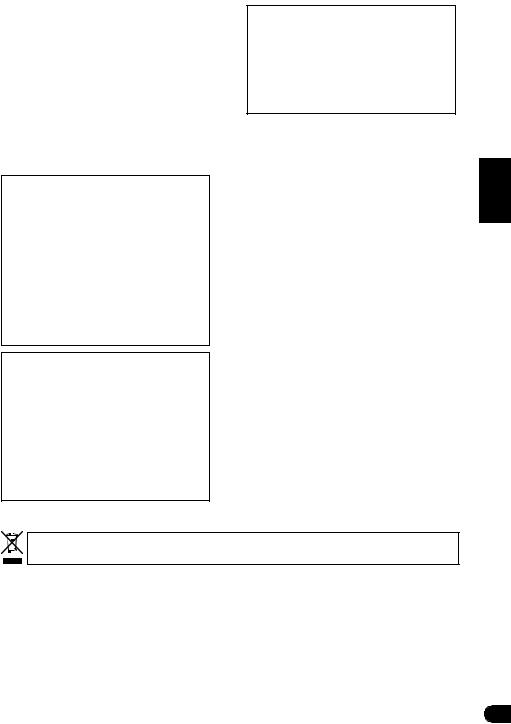
Betriebsumgebung
Betriebstemperatur und Betriebsluftfeuchtigkeit:
+5 °C bis +35 °C, 85 % rel. Feuchte max. (Ventilationsschlitze nicht blockiert) Eine Aufstellung dieses Gerät an einem unzureichend belüfteten, sehr feuchten
oder heißen Ort ist zu vermeiden, und das Gerät darf weder direkter Sonneneinstrahlung noch starken Kunstlichtquellen ausgesetzt werden.
D3-4-2-1-7c*_A1_De
Falls der Netzstecker des Netzkabels dieses Gerätes nicht in die Zusatzsteckdose einer anderen Komponente passt, muss er gegen einen Netzstecker der geeigneten Ausführung ausgewechselt werden. Ein derartiger Austausch des Netzsteckers muss vom Kundendienstpersonal vorgenommen werden. Wenn der vom Netzkabel abgeschnittene ursprüngliche Netzstecker in eine Netzsteckdose eingesteckt wird, besteht akute Stromschlaggefahr! Daher ist unbedingt dafür zu sorgen, dass der abgeschnittene Netzstecker sofort vorschriftsmäßig entsorgt wird. Vor einem längeren Nichtgebrauch des Gerätes, beispielsweise während des Urlaubs, sollte der Netzstecker aus der Netzsteckdose gezogen werden, um das Gerät vollständig vom Netz zu trennen.
D3-4-2-2-1a_A1_De
ACHTUNG
Der POWER-Schalter dieses Gerätes trennt das Gerät nicht vollständig vom Stromnetz. Um das Gerät vollständig vom Netz zu trennen, muss der Netzstecker aus der Netzsteckdose gezogen werden. Daher sollte das Gerät so aufgestellt werden, dass stets ein unbehinderter Zugang zur Netzsteckdose gewährleistet ist, damit der Netzstecker in einer Notsituation sofort abgezogen werden kann. Um Brandgefahr auszuschließen, sollte der Netzstecker vor einem längeren Nichtgebrauch des Gerätes, beispielsweise während des Urlaubs, grundsätzlich von der Netzsteckdose getrennt werden.
D3-4-2-2-2a*_A1_De
Dieses Gerät ist für den Heimgebrauch vorgesehen. Falls bei Einsatz zu einem anderem Zweck (z.B. Langzeitgebrauch zu gewerblichen Zwecken in einem Restaurant oder Betrieb in einem Fahrzeug bzw. Schiff) eine Funktionsstörung auftritt, die eine Reparatur des Gerätes erforderlich macht, werden die Reparaturkosten dem Kunden selbst dann in Rechnung gestellt, wenn die Garantiefrist noch nicht abgelaufen ist.
K041_A1_De
VORSICHT MIT DEM NETZKABEL
Fassen Sie das Netzkabel immer am Stecker. Ziehen Sie nicht am Kabel selbst, und fassen Sie das Netzkabel niemals mit nassen Händen an, da dies einen Kurzschluss oder elektrischen Schlag verursachen kann.
WARNUNG:
Bitte klettern Sie nicht auf dieses Gerät, und setzen Sie sich nicht darauf. Gehen Sie besonders sorgsam vor, wenn sich Kinder in der Nähe aufhalten. Das Gerät könnte beschädigt werden oder umfallen, so dass Verletzungsgefahr besteht.
Nur Modell für Europa
Mischen Sie dieses Produkt, wenn Sie es entsorgen wollen, nicht mit gewöhnlichen Haushaltsabfällen. Es gibt ein getrenntes Sammelsystem für gebrauchte elektronische Produkte, über das die richtige Behandlung, Rückgewinnung und Wiederverwertung gemäß der bestehenden Gesetzgebung gewährleistet wird.
Privathaushalte in den Mitgliedsstaaten der EU, in der Schweiz und in Norwegen können ihre gebrauchten elektronischen Produkte an vorgesehenen Sammeleinrichtungen kostenfrei zurückgeben oder aber an einen Händler zurückgeben (wenn sie ein ähnliches neues Produkt kaufen).
Bitte wenden Sie sich in den Ländern, die oben nicht aufgeführt sind, hinsichtlich der korrekten Verfahrensweise der Entsorgung an die örtliche Kommunalverwaltung.
Auf diese Weise stellen Sie sicher, dass das zu entsorgende Produkt der notwendigen Behandlung, Rückgewinnung und Wiederverwertung unterzogen wird, und so mögliche negative Einflüsse auf die Umwelt und die menschliche Gesundheit vermieden werden.
K058b_A1_De
Pyccкий Español Nederlands Italiano Deutsch Français English
3
De

Inhaltsverzeichnis Aufstellung
Merkmale ............................................ |
4 |
Mitgeliefertes Zubehör ...................... |
4 |
Aufstellung ......................................... |
4 |
Anschlüsse und Betrieb (S-21W) ........ |
7 |
Anschlüsse und Betrieb (S-11) ........... |
9 |
Technische Daten .............................. |
11 |
Störungsbeseitigung ........................ |
12 |
Merkmale
S-21W
•Hohe Ausgangsleistung von 160 W (Spitzenleistung)
•Kompakte Konstruktion und tiefe Bässe
•Phase Control-Technologie
S-11
•Belastbarkeit 150 W
•Rundes Gehäuse
•Phase Control-Technologie
Mitgeliefertes Zubehör
S-21W
•Cinchsteckerkabel (3 m) x 1
•Netzkabel
S-11
•Lautsprecherkabel (4 m) x 3
•Lautsprecherkabel (10 m) x 2
•Rutschfester Untersetzer x 20
•Halterung für Wandmontage x 4
•Schraube (M5) x 4
Sowohl S-21W als auch S-11:
•Garantiekarte
•Bedienungsanleitung (vorliegendes Handbuch)
4
Aufstellen der Lautsprecher
• Wie in der beigefügten Abbildung gezeigt lässt sich ein echter 5.1-kanaliger Surround Sound erhalten, wenn SurroundLautsprecher hinter der Hörposition aufgestellt werden.
1 3
2 4
6 |
7 |
5
1vorderer linker Lautsprecher
2Mittellautsprecher
3vorderer rechter Lautsprecher
4Subwoofer
5Hörposition
6linker Surround-Lautsprecher
7rechter Surround-Lautsprecher
• Der Subwoofer und die SurroundLautsprecher dieser Anlage können nicht in der Nähe eines Fernsehgerätes oder Farbmonitors mit Kathodenstrahlröhre verwendet werden. Bei Verwendung eines eines Fernsehgerätes oder Farbmonitors mit Kathodenstrahlröhre müssen die Lautsprecher in einem größeren Abstand vom Anzeigegerät aufgestellt werden. Andere Geräte, die gegenüber Magnetismus empfindlich sind (z. B. Diskettenlaufwerke, Cassettenrecorder, Videocassettenspieler usw.) sollten ebenfalls in einem größeren Abstand vom Subwoofer und den SurroundLautsprechern aufgestellt werden.
Subwoofer (S-21W)
•Vermeiden Sie beim Tragen des Subwoofers eine Berührung der Grundplatte, da sich der Lautsprecher an dieser Stelle befindet.
•Stellen Sie den Subwoofer so auf, dass seine Vorderseite auf die Hörposition weist.
•Da das menschliche Gehör die Richtung, aus der tiefe Töne das Ohr erreichen, nicht genau wahrnehmen kann, werden die
De
